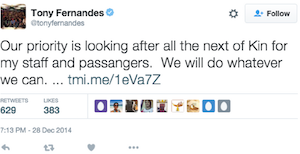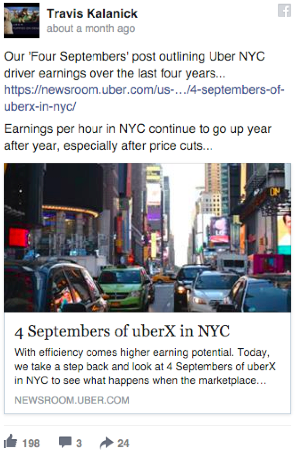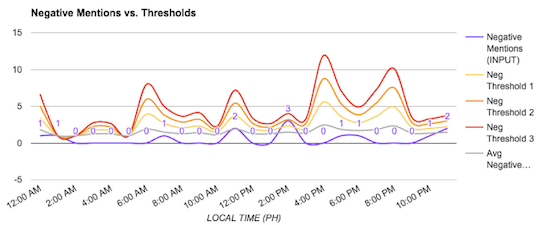The 2016 definitive guide to social media crisis management
Share
Robin Leonard provides a detailed rundown of how large companies should prepare for, recognise and manage social media crises.
I often ask myself is the world getting more dramatic, or is the dramatic news spreading faster than ever before? The reality is that social networks have provided a new avenue for the public to receive news quickly and interact with others on the same topic.
This article discusses what a social media crisis is, and how large companies should prepare for the worst. Many of the models and data are based clients I have worked with across APAC including power, consumer electronics and telecommunications sectors. We were fortunate enough to work closely with them on their historic crisis data as well as in defining ‘crisis playbooks’ that align internal departments and act as an operating procedure for their teams – before, during and after a crisis.
What is a social media crisis?
A social media crisis is a significant increase in the number of brand mentions through online and social channels that have negative sentiment or are damaging to the brand’s reputation and market share. Often online crises are caused by either an offline or online event and typically increase in scale when picked up by mass media or influencers.
Not all social media crises originate from an online event, most are caused by real life customer complaints from offline experiences. Take a telco for example, their most common day to day causes of volume and negative sentiment spikes are outage or service related.
Therefore, it is essential to stop considering web and social channels as a floodgate, but instead leveraging them as a powerful communication tool, that acts as a thermometer, a loud-speaker, and a low cost-per-inquiry, easy to scale contact centre.
Why do some crises escalate quickly and others don’t, but should?
The common catalyst for a social media crisis is often a news channel or influencer with significant reach that posts on the topic. Often the crisis will first be visible online hours before anybody starts talking about it, but as soon as a major news outlet shares it, it tends to accelerate.
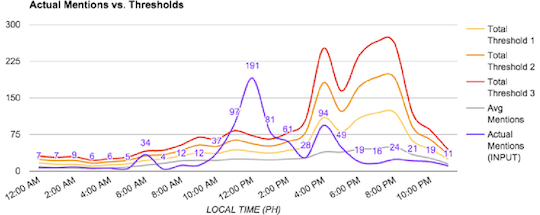
A day of actual social media mentions visualised against hourly thresholds that have been set up based on daily averages.
What impact does a social media crisis really have?
In a 2013 study, McKinsey found a direct correlation between negative sentiment and reduced sales. It is therefore important for the C-Suite to pay attention to social listening metrics as they are macro signals that give you fast feedback, and should be used to trigger and support decision making.
–
Related: Mark Ritson thinks marketers are being fed bullshit about social media »
–
Social listening metrics that matter during a crisis
A social media crisis has several common attributes that allow us to classify, categorise and rank crises against each other.
For example, we found that with an energy client, bad weather resulting in widespread power outages caused a high volume of mentions but relatively low negative mentions, whereas a localised power outage didn’t cause much overall volume, yet it had a high spike of negative sentiment.
Because of this, it is important to monitor for spikes in both total mentions and mentions with negative sentiment.
Responding can reduce crisis duration by 50%
In a recent study by SDL Social Intelligence, when comparing famous social media crises between Domino’s, Nestle and United Airlines, it showed that because Nestle had tried to ignore their PR crisis, it had a 50% longer duration before average sentiment returned to normal than Dominos or United Airlines, who had both responded and apologised to the public.
Air Asia CEO Tony Fernandes did this perfectly when they lost a flight 8501 in December 2014.
How to be prepared for a social media crisis
One of my favourite quotes is Benjamin Franklin’s ‘If you fail to plan, you plan to fail.’ There are so many moving parts to the social and digital ecosystem, and to quickly scale social customer service in the event of a crisis, there needs to be a robust system and process in place already.
This can prove troublesome if a brand has their proverbial pants down, in the face of a crisis.
Create a social crisis playbook
There should be a very clear plan in place in the event of a crisis on social media so that the brand can respond quickly and take appropriate steps to mitigate impact.
A social crisis playbook acts as the procedure document that aligns all business units on how to prepare, monitor and respond in any online crisis situation.
Understand roles and responsibilities
It is important to understand the internal stakeholder environment and how each business unit plays a role in a crisis situation. For example if an airline loses a plane, HR needs to manage staff communications and control what they do and don’t share, marketing need to shut down promotions, service crew need to understand what happened, communications need to articulate the public response, customer services need to handle a high volume of complaints with sensitivity across multiple channels, including social media.
A real-life social media crisis is a time constrained and complicated orchestra of multiple parties, so it is important to agree beforehand on what each party has to do.
Define how you will use each channel in case of an emergency
Facebook, Twitter, Instagram, live chat, web – they all have unique properties that can be useful in a social media crisis. For example, Twitter, a popular social customer service channel, is also a great thermometer because of the ease of measuring public sentiment around topics at scale. Facebook Messenger can now be used by brands to resolve customer issues privately in chat format.
Update your website with crisis information and FAQs or use a separate crisis ‘dark site’ to refer unhappy customers to. This helps deflect calls from contact centres and other high-cost service channels.
Review historical crisis data to define accurate warning thresholds
Social media data is incredibly rich if you know how to read it. Using tools such as Salesforce Radian6 it is possible to measure up to five years of historical social mention raw data so you can get the actual impact of historic crises on social media, and compare crises against each other to get a contextual appreciation of size.
Roll out company-wide training
It is important that once the process is defined, all stakeholders receive regular mandatory training on social crisis management. The training should be customised to suit the audiences that play different roles – for example the executive training would be different to the general staff training. A high profile executive can have a huge personal impact on a crisis by responding personally, like how Uber CEO Travis Kalanick took to Facebook after receiving an open letter from an NYC Uber Drivers Network, complaining about recent fare cuts.
Have a trained crisis team on standby
A rapid spike in social media mentions can heavily disrupt response times and service levels. Just like a small town has a volunteer firefighting unit, a business also needs a trained and certified on-call crisis response team that can be called in to help manage volume and maintain service levels. These can even be team members from other parts of your business, like accounting or HR, who have passed the test and requirements.
Build a social command centre
A social command centre is typically a war room that has enough seats and computers to house a crisis team working closely together in a crisis situation. Large screens are typically used to show visualisations of what is happening live on social media so the team can stay aware of any trending topics, influencers or if the thresholds are being crossed.
Run quarterly crisis drills
No different to a fire drill, it’s important to ensure your employees are ready and prepared for a real-life crisis situation. Create a realistic scenario and involve the core business units that need to act in a crisis so they can practice and cement their familiarity with the process.
Enable scaleable social customer service with the right IT architecture
It is incredibly important to implement a robust social customer service architecture that won’t fall over when your volume goes from five mentions per hour to 1500 mentions per hour. It is impossible to effectively manage such volume using ‘native’ Facebook and Twitter, especially if there are multiple team members.
Sometimes complaints need to be escalated, and complaints should always be tracked through to closure. The best way to do this is with your existing CRM platform, which will typically include a trouble ticket or case management feature.
How to monitor for a social media crisis
Set hourly and daily crisis thresholds
With historical social mention data available it is possible to calculate hourly and daily thresholds for volume and sentiment that should trigger notifications or escalation. An hourly threshold should be sensitive enough that it picks up anything unusual for that time of day and triggers a human to review the trend, but it shouldn’t necessarily trigger a full crisis escalation.
It is important to test your thresholds and constantly optimise them if they are triggering false alarms.
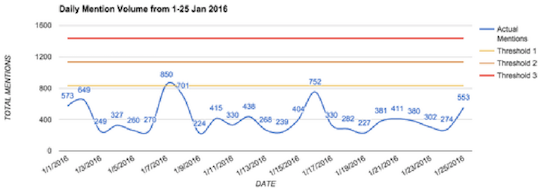
Example data of daily actual mentions tested against crisis thresholds to see if they trigger escalation.
Check hourly and around the clock
Ideally, a 24/7 social monitoring team would check every hour if there is an unusual volume of mentions or negative mentions in that hour. If it crosses a threshold, then they’ll need to manually review the spike and assess using clear criteria in the playbook whether to escalate.
After all, most large businesses pay a security team to watch over their physical office to
prevent stealing or property damage. The later a brand responds to a crisis, the more reputation damage may be done, and potentially translating into a revenue impact. It needs to be monitored by a human to properly discern if there is a real threat or not when a threshold is triggered.
How do you know when a crisis is a crisis?
The decision on whether to escalate is not as easy as following the numbers, sometimes there are other factors involved that need to be part of the decision. For example:
- Has the hourly crisis threshold been exceeded for more than 3 consecutive hours?
- Have any news outlets or influencers talked about the issue?
- Is the issue likely to continue for more than 24 hours?
- Has the spike exceeded, or is likely to exceed the daily threshold?
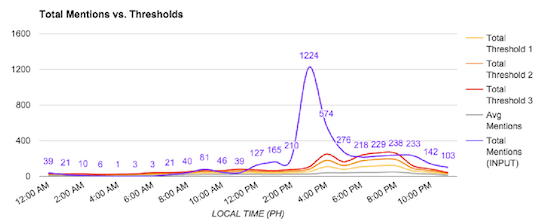
You will quickly know when a real crisis hits. This is what happened to a power company in the Philippines when Typhoon Glenda hit in 2013 causing millions of people to be without power for nine days.
What to do if a social media crisis happens
Follow your crisis action plan
In your playbook you should have a ‘crisis action plan’ which is your immediate plan on what to do in the case of a crisis. Before a crisis can be considered as such, it should go through reviews and have a steering group agree to the best course of action.
The crisis action plan should include:
- hourly crisis monitoring,
- regular crisis notifications and updates,
- daily crisis reporting,
- updated FAQs,
- update website/dark site with crisis information,
- response guidelines to be followed by social customer service teams,
- press release to mass media and influencers, and
- pause marketing campaigns, change social page images.
Hourly and daily crisis watch reporting
You should actively monitor every hour, and assign somebody to pay close attention to the general listening feed of brand, industry and competitor mentions so any changes or new trends can be identified quickly. A reporting schedule, templates and recipient list depending on crisis severity should be made available in your social crisis playbook.
Publish crisis information and FAQs online
Publish the latest updates, information and FAQs on your website or crisis ‘dark site’ so you can refer people there. This will also be a resource for staff and media to refer to as an authority on the crisis. If you have the most comprehensive information on your own crisis, you will have control of the message.
Communicate with employees, media and influencers at scale
Just like traditional PR in a crisis, you need to keep all your stakeholders informed with your side of the story. Keep politicians informed so they can speak to the topic in public; keep your staff up to date and arm them with shareable messages; or keep news outlets informed with the most comprehensive information so they use you as a trusted source.
Now we have powerful multi-channel marketing tools available that help make hyper targeted communications like this easier to do at scale. Use social, email, SMS, web and push notifications in combination to reach everybody that needs to know about your crisis.
Crisis post mortem and de-brief
Social listening data provides rich information on the macro feelings and emotions of netizens, as well excellent statistical data that can be analysed and compared, just like how an earthquake is measured on the Richter Scale or how a cyclone is measured in windspeed.
A crisis post-mortem report should be created that is used to chronicle the crisis, and review the performance of your social crisis playbook.
In summary, social and online channels are important tools to leverage and control in the event of a brand crisis. By listening to social media, a brand can quickly identify an anomaly and understand if escalation is required. Once a social media crisis emerges, it is important to be prepared with a playbook, command centre, trained staff and all the tools required to mitigate impact and reduce risk to reputation or market share.
_
Robin Leonard is CEO of AFDigital.
* * * * *
The current print issue of Marketing is ‘The Social Issue,’ purchase a subscription to receive a copy, which covers all things social
* * * * *


